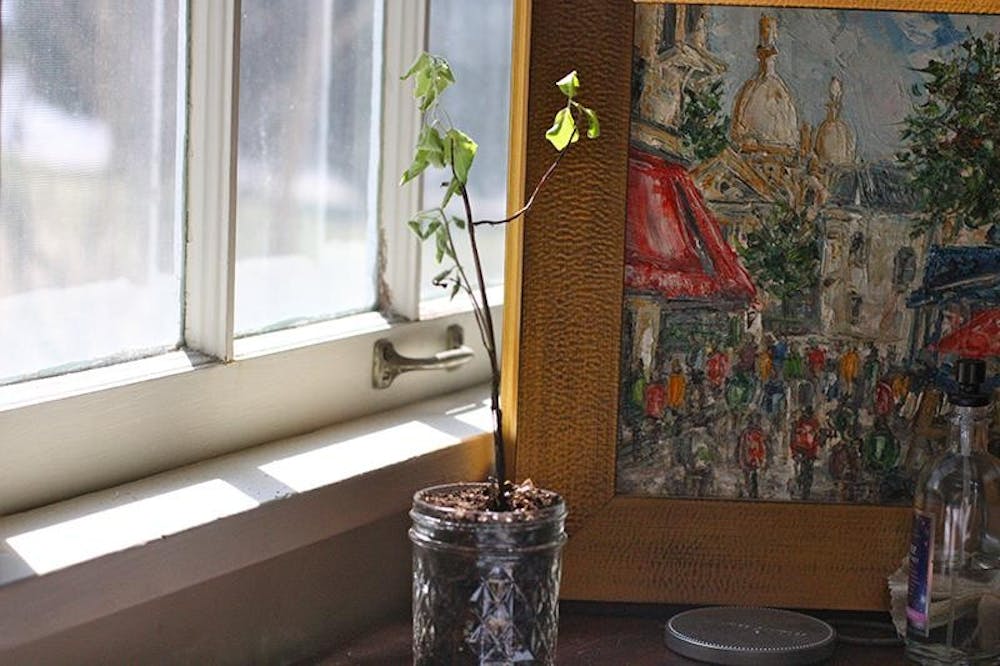Birds are chirping, students are “dartying,” and UGG boots have (almost) disappeared.
Has spring finally arrived in Bloomington?
While I’m wary of making this statement for fear of scaring it away, it appears that our colder days are behind us. I’m not one who dislikes winter, as I’ve lived in Indiana all my life and appreciate all four seasons, but once April arrives, I’m ready to put away my winter coat.
And when it’s warm out, I’m ready to stop being a hermit and get motivated to rejoin the outside world. This season started with an enjoyable stroll to interview for my online journalism class.
Upon arriving at my source Lucille’s house, I couldn’t help but take note of the incredible gardens in her lot. While they were barren for the season, she kept her passion for gardening alive in her house. We talked about genetically modified foods for half an hour, and recognizing my passion in organics and gardening, she gave me a seedling of pineapple sage as we parted.
As the weather warms up, it’s a great time of the year to start growing produce and herbs inside before transferring them outdoors. Therefore, my spring-themed DIY this week is DIY: indoor garden edition. While I now have pineapple sage growing in my window, you can care for any herb that you desire. Then, when the weather is warm enough, you can transfer your herb outside or even trim it and keep it indoors.
No green thumb is necessary for this. Just pick an herb or produce, use your search engine research skills about caring for it (how often to water it, if it likes sunlight, etc.) and get out there! What better way to thank Mother Nature for the warm weather than sending some oxygen back into the atmosphere? The world is a beautiful place — let’s keep it that way.
What you’ll need:
a small pot, a seedling (also known as a baby plant) or seeds, potting soil
1. Pour potting soil loosely into your pot, about two inches high.
2. Add your seedling or seed, and fill the soil up approximately one to two inches.
3. Water your plant, keep it in (or out) of sunlight and care for it.
Why to grow:
Are pets too high-maintenance? Not enough return on investment? If you can’t handle a cat, try a plant. Specifically, grow some herbs (notice we said herbs, not herb). You get to put the love into them that you’d give to a pet, and when they get big enough, you get to eat them. Find small pots and containers at Goodwill, buy some nice gardening dirt, and you’re set — cute decorations and edible pets, all in one.
Pro tips:
Make sure your containers have holes in the bottom, and buy a shallow dish or tray to push under them. The soil needs to drain as you water it, and you can use the amount of pooled water as a gauge of how much more your plant needs. Turn your plants often to make sure they grow evenly. Only harvest from them when they’re at least 6 inches tall, and don’t take more than a few leaves at a time. Wait for growth equal to the amount you took before you harvest again.
HERBS
Mint:
This herb prefers partial shade and does better in containers than it does in actual gardens. Mint will overtake other plants at a frightening speed, so it’s best to keep it isolated. It’s not too particular about soil. As long as you water it a lot and put it in the sunniest window you have, it should do well. GOES IN: Mojitos. And roasted vegetables and light salads.
Lavender:
This flowery herb does well inside as long as it has lots of sunlight. You can actually water lavender less than your other plants — it prefers looser, more arid soil. If you’re not satisfied with the fabulous smell, the blossoms are actually edible. GOES IN: Your flower vase, aiolis, salmon, dense breads and cakes
Oregano:
Oregano definitely needs full sun (it requires six to eight hours of light a day), but it does well in container gardens as long as it’s in a sunny place. They only need to be watered once in a blue moon. GOES IN: Italian food. Duh. Oregano always plays nice with tomatoes.
Parsley:
Parsley can take partial sun in a pinch, but it will grow faster in an east- or west-facing window. It’s a hardy plant that grows well in normal soil — you don’t necessarily need fancy gardening dirt. If you move it outside in the summer, it attracts butterflies. GOES IN: Rice dishes (like taboulehs and pilafs), pastas
Rosemary:
This herb grows well both inside and outside and does well in containers — it’s basically stupid-proof. Rosemary actually prefers soil with lime content, so add a few crushed eggshells to the dirt you pot it in. Grow it in a south-facing window for best results. GOES IN: chicken and fish dishes, savory breads
Chives:
These pretty little herbs do well in containers, and they’ll brighten up your kitchen with their pink blooms. They like sun and need six to eight hours per day. Don’t start your chives from seed — replant an already established plant and cut off the tops to encourage new growth. GOES IN: pretty much any savory dish. They have a mild oniony, garlicky flavor that tastes particularly good with creamy sauces, white meats and potatoes.
DIY: Grow your own herbs

Get stories like this in your inbox
Subscribe





